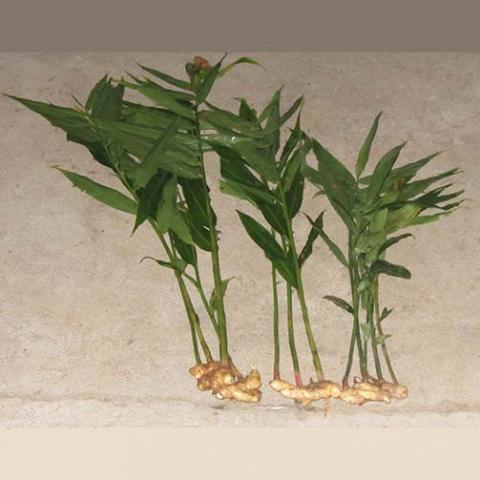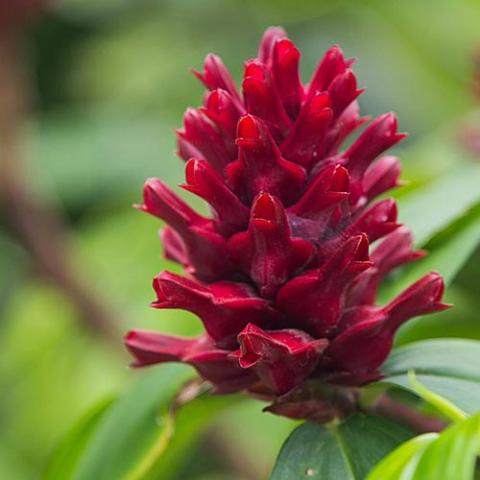NAME(S)
TAXONOMY
PLANTAE ID
THERAPEUTIC
Genus species (Plantae): Zingiber officinale
Ginger (Zingiber officinale) is a flowering plant whose rhizome, ginger root or ginger, is widely used as a spice and a folk medicine. It is a herbaceous perennial which grows annual pseudostems (false stems made of the rolled bases of leaves) about one meter tall bearing narrow leaf blades. The inflorescences bear flowers having pale yellow petals with purple edges, and arise directly from the rhizome on separate shoots.
Ginger is in the family Zingiberaceae, which also includes turmeric (Curcuma longa), cardamom (Elettaria cardamomum), and galangal. Ginger originated in Maritime Southeast Asia and was likely domesticated first by the Austronesian peoples. It was transported with them throughout the Indo-Pacific during the Austronesian expansion (c. 5,000 BP), reaching as far as Hawaii. Ginger is one of the first spices to have been exported from Asia, arriving in Europe with the spice trade, and was used by ancient Greeks and Romans. The distantly related dicots in the genus Asarum are commonly called wild ginger because of their similar taste. In 2018, world production of ginger was 2.8 million tonnes, led by India with 32% of the world total.
Etymology
The English origin of the word "ginger" is from the mid-14th century, from Old English gingifer, from Medieval Latin gingiber, from Greek zingiberis, from Prakrit (Middle Indic) singabera, from Sanskrit srngaveram. The Sanskrit word is thought to come from a Dravidian word that also produced the Malayalam name inchi-ver (from inchi "root"), an alternative explanation is that the Sanskrit word comes from srngam "horn" and vera- "body" (describing the shape of its root), but that may be folk etymology. The word probably was readopted in Middle English from Old French gingibre (modern French gingembre).
Origin and distribution
Ginger originated from Maritime Southeast Asia. It is a true cultigen and does not exist in its wild state. The most ancient evidence of its domestication is among the Austronesian peoples where it was among several species of ginger cultivated and exploited since ancient times. They cultivated other gingers including turmeric (Curcuma longa), white turmeric (Curcuma zedoaria), and bitter ginger (Zingiber zerumbet). The rhizomes and the leaves were used to flavor food or eaten directly. The leaves were also used to weave mats. Aside from these uses, ginger had religious significance among Austronesians, being used in rituals for healing and for asking protection from spirits. It was also used in the blessing of Austronesian ships.
Ginger was carried with them in their voyages as canoe plants during the Austronesian expansion, starting from around 5,000 BP. They introduced it to the Pacific Islands in prehistory, long before any contact with other civilizations. Reflexes of the Proto-Malayo-Polynesian word *laqia are still found in Austronesian languages all the way to Hawaii. They also presumably introduced it to India along with other Southeast Asian food plants and Austronesian sailing technologies, during early contact by Austronesian sailors with the Dravidian-speaking peoples of Sri Lanka and South India at around 3,500 BP. It was also carried by Austronesian voyagers into Madagascar and the Comoros in the 1st millennium CE.
From India, it was carried by traders into the Middle East and the Mediterranean by around the 1st century CE. It was primarily grown in southern India and the Greater Sunda Islands during the spice trade, along with peppers, cloves, and numerous other spices.
History
The first written record of ginger comes from the Analects of Confucius, written in China during the Warring States period (475–221 BC). In it, Confucius was said to eat ginger with every meal. In 406 AD, the monk Faxian wrote that ginger was grown in pots and carried on Chinese ships to prevent scurvy. During the Song Dynasty (960–1279), ginger was being imported into China from southern countries.
Ginger was introduced to the Mediterranean by the Arabs, and described by writers like Dioscorides (40–90 AD) and Pliny the Elder (24–79 AD). In 150 AD, Ptolemy noted that ginger was produced in Ceylon (Sri Lanka). Raw and preserved ginger was imported into Europe during the Middle Ages. In 14th century England, a pound of ginger cost as much as a sheep.
Horticulture
Ginger produces clusters of white and pink flower buds that bloom into yellow flowers. Because of its aesthetic appeal and the adaptation of the plant to warm climates, it is often used as landscaping around subtropical homes. It is a perennial reed-like plant with annual leafy stems, about a meter (3 to 4 feet) tall. Traditionally, the rhizome is gathered when the stalk withers; it is immediately scalded, or washed and scraped, to kill it and prevent sprouting. The fragrant perisperm of the Zingiberaceae is used as sweetmeats by Bantu, and also as a condiment and sialagogue.
Research
Evidence that ginger helps alleviate nausea and vomiting resulting from chemotherapy or pregnancy is inconsistent. There is no clear evidence of harm from taking ginger during pregnancy, but its safety is undefined. Ginger is not effective for treating dysmenorrhea. There is some evidence for it having an anti-inflammatory effect, and improving digestive function but insufficient evidence for it affecting pain in osteoarthritis.
Adverse effects
Allergic reactions to ginger generally result in a rash. Although generally recognized as safe, ginger can cause heartburn and other side effects, particularly if taken in powdered form. It may adversely affect individuals with gallstones, and may interfere with the effects of anticoagulants, such as warfarin or aspirin.
Reference: Wikipedia
Photo: Marcin Konsek / Wikimedia Commons / CC BY-SA 4.0





